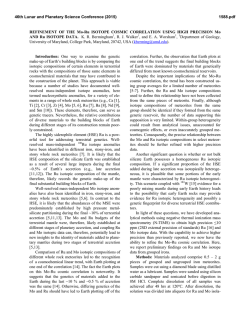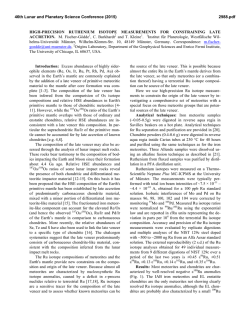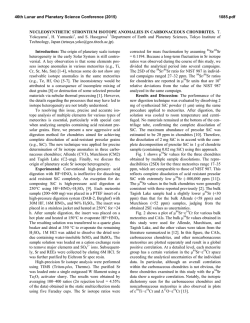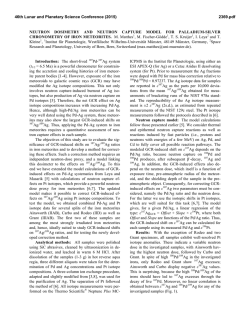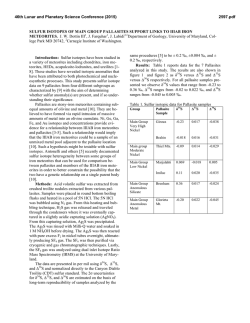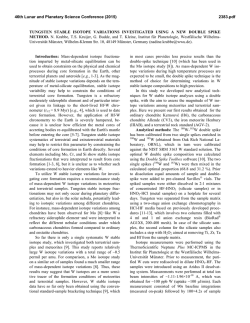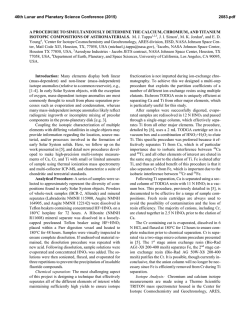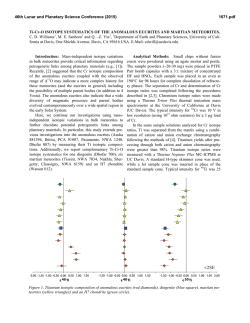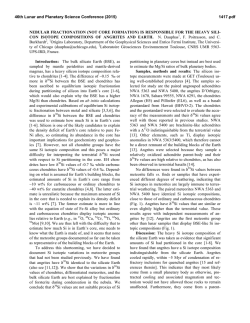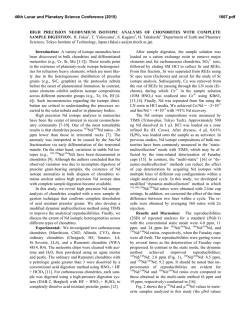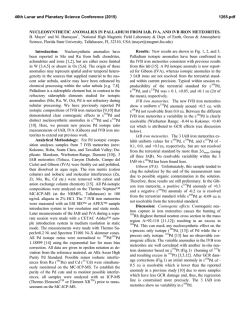
ISOTOPIC CONSTRAINTS ON THE ORIGIN OF IIE IRON
46th Lunar and Planetary Science Conference (2015) 2697.pdf ISOTOPIC CONSTRAINTS ON THE ORIGIN OF IIE IRON METEORITES. M. Fischer-Gödde1, T. S. Kruijer1, T. Kleine1 and J. T. Wasson2. 1Institut für Planetologie, Westfälische Wilhelms-Universität Münster, Wilhelm-Klemm-Str. 10, 48149 Münster, Germany. Correspondence: [email protected], 2Institute of Geophysics and Planetary Physics, University of California, Los Angeles, CA 90095-1567. Introduction: Group IIE iron meteorites, together with groups IAB and IIICD, are classified as nonmagmatic iron meteorites [1]. These are distinguished from magmatic iron meteorites in having element-Ni trends that cannot be explained by fractional crystallization [2,3]. They also contain abundant silicate inclusions, which are largely absent in members of the magmatic groups. The non-magmatic irons, therefore, are not considered as samples of the metal cores of planetesimals, but more likely formed on partially differentiated bodies or within impact-generated melt pools near the surface of undifferentiated asteroids [e.g. 3]. The trace element systematics of IIE irons are complex. In log-log plots of Ga, Ge and Ir versus Ni, the IIE irons display scattered trends that are inconsistent with variations expected from fractional crystallization [3], yet in plots of As and Au versus Ni they seem to define a fractional crystallization trend [3,4]. Nevertheless, the small variations in W and Ir with Ni argue against an origin by fractional crystallization. The IIE iron meteorites, therefore, are interpreted to have formed in impact-generated melt pools located near the surface of a chondritic parent body [e.g. 3]. Silicate inclusions in IIE irons have similar O isotope compositions than H chondrites [5], which has led to the idea that the IIE irons formed by impact melting on the H chondrite parent body [3]. A genetic link between IIE irons and H chondrites would be consistent with similar Mo isotope anomalies reported for these two groups of meteorites [6,7]. Group IIE irons can be subdivided into two distinct age groups. One group is characterized by formation ages (mostly based on Ar-Ar) of ~4.5 Ga and cosmic ray exposure (CRE) ages of 50-600 Ma, whereas the other group shows evidence for late impact resetting at ~3.7 Ga and is characterized by younger CRE ages of 3-15 Ma [8]. Currently, the most precise constraints on the formation age of IIE irons come from Hf-W isotope systematics. The IIE irons have significantly more radiogenic W isotope compositions than magmatic iron meteorites, indicating late metal-silicate separation or re-equilibration until up to ~15 Ma after CAI formation [9]. Such young Hf-W ages would be consistent with formation of IIE irons from impactgenerated melt pools. The objectives of this study are to constrain the origin and formation history of the IIE iron meteorites through a combined Ru, Mo, Pt, and W isotope study. The ultimate goals of our multi-isotopic approach are (1) to better constrain the origin of IIE irons and in particular its relation to H chondrites using coupled Mo and Ru isotope analyses, and (2) to precisely determine the formation time of IIE metal using Hf-W isotope systematics. Combined Mo-Ru isotope measurements are useful because most iron meteorites and also ordinary and enstatite chondrites are characterized by distinct and correlated nucleosynthetic Mo and Ru isotope anomalies, making coupled Mo-Ru isotope systematics a powerful tool to assess potential genetic relationships among meteoritic materials [6,7,10,11]. One caveat when applying high-precision Mo, Ru and W isotope measurements to constrain the formation history of iron meteorites is that the isotopic compositions may have been modified by secondary neutron capture during extended cosmic ray exposure. Such effects are well documented for W isotopes [12-14] and we have recently shown them to be also significant for Ru [11]. Determining the isotope compostion of iron meteorites to high precision, therefore, also requires us to assess the magnitude of the neutron fluence in each sample, which can be quantified using Pt isotopes [12-14]. Here we present the first Ru isotope data for five members of the IIE iron meteorite group (Arlington, Colomera, Miles, Mont Dieu, and Weekeroo Station). Analytical techniques: Iron meteorite samples (~1 g) were digested in reverse aqua regia in Savillex beakers on a hot plate. After dissolution, Os was extracted from the aqua regia into CCl4 [15]. An aliquot corresponding to about 30% was taken from which Ru was separated from the sample matrix by cation exchange chromatography [16] and further purified by mirco-distillation [17]. Ruthenium isotopes were measured on a ThermoScientific Neptune Plus MCICPMS at the University of Münster. The measurements were typically performed with total ion beam intensities of ~7.5 × 10-11 – ~4.4 × 10-10 A, which was obtained for a 100 ppb Ru standard solution. Isobaric interferences of Mo and Pd on Ru masses 96, 98, 100, 102 and 104 were corrected by monitoring 97Mo and 105 Pd. Measured Ru isotope ratios were normalized to 99 Ru/101Ru using the exponential law and are reported as εiRu units representing the deviation in parts per 104 from the terrestrial Ru isotope composition. Accuracy and precision of the Ru isotope measurements were evaluated by replicate digestions and multiple analyses 46th Lunar and Planetary Science Conference (2015) of the NIST 129c steel doped with ~500 to ~2000 ng Ru from an Alfa Aesar standard solution. The external reproducibility (2 s.d.) of the Ru isotope analyses obtained for 49 individual measurements from 9 different digestions over a period of the last two years is ±0.45 ε96Ru, ±0.51 ε98Ru, ±0.13 ε100Ru, ±0.14 ε102Ru, and ±0.35 ε104Ru. Results: The IIE irons display negative ε100Ru anomalies ranging from –0.31 for Arlington to –0.13 for Mont Dieu (Fig. 1). Mont Dieu is the only IIE sample for which the ε100Ru anomaly is not fully resolved from the terrestrial Ru isotope composition. The anomalies in ε100Ru are correlated with negative anomalies in ε102Ru, although the latter are in general less well resolved than those in ε100Ru. Most samples also display positive ε96Ru and ε98Ru values, but these are not resolved from the terrestrial standard. The ε104Ru values of all analyzed meteorite samples overlap with terrestrial Ru. 100 Fig. 1: ε Ru values of IIE iron meteorites in comparison to ε100Ru values of chondrites and iron meteorites. Fig. 2: Average Ru isotope composition of IIE iron meteorites shown as εiRu vs. iRu plot. Error bars represent 95% confidence intervals. The dashed line illustrates a calculated isotopic pattern for a deficit in sprocess isotopes [18]. 2697.pdf Discussion: The average Ru isotope composition obtained for IIE iron meteorites shows a pattern that is consistent with a deficit in s-process isotopes (Fig. 2). Similar patterns have been observed for other iron meteorites [11], but of varying magnitude (Fig. 1). The Ru isotope composition of the IIE irons overlaps with that of ordinary chondrites and would thus be consistent with a genetic relationship between these two groups of meteorites. Note, however, that both also overlap with the Ru isotope composition of IVA iron meteorites. Moreover, at the current level of analytical resolution the Ru isotope composition of the IIE irons also seems to overlap with enstatite chondrites. The ε100Ru values of the IIE irons may be slightly more negative than those measured, because neutron capture reactions would lower ε100Ru values. The scatter of the ε100Ru values observed for the investigated IIEs and in particular the less negative ε100Ru value of Mont Dieu might reflect such neutron capture-induced isotope shifts. We will quantify these effects by measuring the Pt isotope composition for the same samples. We will also analyze the W isotope compositions on aliquots of the same samples used for the Ru isotope measurements, to determine Hf-W ages for each of the samples. It will be interesting to see whether all IIE irons are characterized by a common pre-exposure W isotope composition (i.e., unaffected by neutron capture) or if there are W isotope differences. The latter would imply distinct formation times, which might be expected if the IIEs formed as impact melt pools near the surface of a chondritic asteroid. References: [1] Scott E. R. D. and Wasson J. T. (1976) GCA, 40, 103-115. [2] Scott E. R. D. and Wasson J. T. (1975) Rev. Geophys. Space Phys., 13, 527546. [3] Wasson J. T. and Wang J. (1986) GCA, 50, 725-732. [4] Scott E. R. D. (1979) In Asteroids (de. T. Gehrels), pp. 892-925, Univ. of Arizona, Tucson. [5] Clayton R. N. Mayeda T. K. (1996) GCA, 60, 19992017. [6] Burkhardt C. (2011) EPSL, 312, 390–400. [7] Dauphas N. et al. (2004) EPSL, 226, 465–475. [8] Bogard D. D. et al. (2000) GCA, 64, 2133-2154. [9] Markowski A. et al. (2006) EPSL, 242, 1-15. [10] Chen J. H. et al. (2010) GCA. 74, 3851-3862. [11] Fischer-Gödde et al. (2015) GCA, in Review. [12] Kruijer T. S. et al. (2013) EPSL, 361, 162-172. [13] Kruijer et al. (2014) Science, 344, 1150-1154. [14] Wittig N. et al. (2013) EPSL, 361, 152-161. [15] Cohen A. S. and Waters F. G. (1996) Anal. Chim. Acta, 332, 269-275. [16] Becker H. et al. (2002) Analyst, 127, 775-780. [17] Birck J.-L. et al. (1997) Geostand. Newsl., 21, 21-28. [18] Arlandini C. et al. (1999) ApJ, 525, 886-900.
© Copyright 2026
